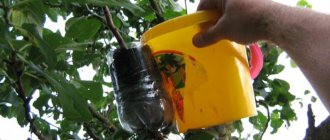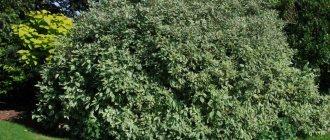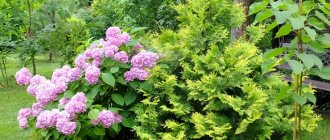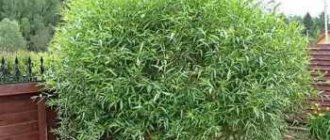Advantages of gooseberry propagation in autumn
There are several reasons to propagate and immediately transplant gooseberries to a new location in the fall.
- Early start of gooseberry growing season in spring. You may simply not have time to take cuttings before flowering begins. Shoots during the flowering and fruiting period are not suitable for propagation, since the rooting process will take a long time, and the cuttings themselves will require careful care, which is difficult to organize in the midst of sowing work.
- When propagating gooseberries by layering, the seedlings will be ready for transplanting by autumn.
- It is also better to divide gooseberry bushes in the fall, when they are in the dormant stage.
In autumn, as a rule, there is enough moisture and no sweltering heat. Therefore, the seedlings have every chance of successful engraftment.
Reproduction by shoots
This is the most “humane” and non-traumatic way to propagate gooseberries. It consists of timely planting of young shoots that naturally form around the bush.
It is best to carry out in the fall after the end of seasonal work. Young shoots are carefully separated from the mother plant and transferred to a new location. It is best to fill the area from which the shoots were dug up with well-rotted compost to improve the composition of the soil under the old bush.
Important: if large berries are expected from the bush, young shoots must be removed systematically. An overgrown bush degenerates and gets sick, and harvesting from it is real torture. When the owner does not intend to plant the shoots, they can simply be destroyed or donated.
If the gooseberry is reluctant to grow, the growth of young shoots for reproduction can be provoked by simple agricultural techniques:
- in the spring, the earth around the bush is well loosened, fluffed up and enriched with mulch;
- gooseberries are trimmed;
- They dig a ditch around the bush and provide abundant watering;
- when the young shoots grow into the bush, they hill up, covering them with a third layer of soil (you can add brought compost on top);
- the shoots are pinched for better branching, removing three to five leaves from above;
- the root system of young shoots will be formed in the fall;
- At the discretion of the owner, the shoots can be planted in winter, or you can wait until next spring.
Methods for propagating gooseberries in autumn
It is difficult to say that any method of reproduction is specifically autumn. As a rule, either the initial or final stages of work occur in the fall.
- When propagating gooseberries by layering in the fall, prepared seedlings are separated from the mother bush, inspected and planted in separate beds for growing or in a permanent place. This depends on the degree of development of the root system and the method used to obtain layering.
- If you want to propagate gooseberries with cuttings, then autumn is the time to harvest them, as well as to plant already prepared seedlings in open ground.
- Dividing gooseberry bushes is probably the only method that is performed in the fall, although some work will still have to be done during the year preceding planting the bushes.
Rooting technology
Before planting the cuttings, you need to water the soil well in the box or greenhouse. To do this, the soil is first watered with a small amount of potassium permanganate solution. Afterwards, pour a large amount of water. In this case, potassium permanganate penetrates into the deep layers of the substrate and disinfects them.
After abundant watering, allow the water to drain and plant the cuttings. They are placed in the soil with a slight diagonal slope. Planted in rows, every 3-4 cm in the row. The distance between rows is 10 cm.
The planted branches are covered with gauze and sprayed with water. The gauze will store moisture and will not allow it to stagnate on the surface of the leaves in the form of drops.
Cover the greenhouse or box with polyethylene. Individual bushes can be covered with a cut plastic bottle (if the hole is small).
Propagation times for gooseberry bushes
If we talk about gooseberry propagation in the fall, then the period of main work falls on the months of September and October. This time is most favorable for planting seedlings.
You can wait until mid-November to cut cuttings if weather forecasters do not promise severe frosts. This is especially true if the harvested planting material is to be stored at home until the warm season.
Attention!
When choosing a specific time for gooseberry propagation, you should focus on weather conditions. When hot and dry weather sets in, work should be postponed. But you shouldn’t delay it if you plan to plant harvested seedlings in a permanent place. They need time to take root.
How to take gooseberry cuttings in the fall
Growing gooseberries from cuttings in the fall or at other times of the year is not the most effective method. But it is precisely this that allows you to obtain a large amount of planting material at a time.
Cuttings can be green, combined and woody. Each type has its own harvesting time and planting rules.
Cutting and preparing planting material
When using woody shoots, two-year-old seedlings are planted. They give a high percentage of survival rate if you follow all the rules of agricultural technology. It is worth noting that not all gooseberry varieties tolerate this method of propagation well.
For gooseberry cuttings in the fall, choose healthy bushes, no older than 10 years. Preference is given to 3-5 year old plants, which up to this point have produced a good harvest of large berries. It should be remembered that the older the bush from which cuttings are taken, the worse they take root.
Planting material is cut from the shoots of the current or last year. The main thing is that the bark on them begins to become woody. The cuttings should be about 15-20 cm long and have from 2 to 4 buds. The lower cut is made at an angle of 45 degrees, 1.5 cm below the first bud. The top cut is made at a right angle.
Attention!
Cuttings are a rather traumatic procedure for a bush. All work should be carried out with a clean and sharp tool, a knife or pruning shears. After cutting cuttings from one gooseberry bush, the tools should be disinfected and only then proceed to cutting twigs from another bush.
How to root gooseberry cuttings in autumn
Further actions depend on the method of storing, planting and rooting gooseberry cuttings harvested in the fall.
Many gardeners, especially those living in cold climates, prefer to store them until spring. To do this, their ends are moistened in a growth stimulator, tied into bundles of 10-20 pieces each and placed vertically in a bucket, at a short distance from each other. Carefully cover with a mixture of peat and sand so that the height of the soil layer above the cuttings is 10-15 cm.
Features of cuttings in spring
Growing gooseberries from cuttings in the spring is suitable for those gardeners who do not have time to prepare and care for shoots during the winter. If you follow all the rules, you can plant a highly productive shrub that will delight you with a good harvest for a long time. Cuttings are performed in early spring before buds appear.
When selecting planting specimens, it is worth considering a number of nuances and carefully assessing their condition. If there are traces of diseases or parasites on the surface of the branches, it is better to exclude them. Otherwise, the cuttings will not be able to form stable immunity.
It is also important to study the structure of the bush. For cuttings in spring, you can use green or semi-lignified shoots, the age of which does not exceed 1 year. Healthy material has a brown-green tint and elastic fabrics.
Cuttings can be taken from the tops of branches. The main thing is that they have a length of 25 cm and contain from 4 to 6 healthy buds.
Having decided on the specimens to plant, you need to move them to the refrigerator for 24 hours. Next, make a cut at an angle of 45° and place the cuttings in a container with clean liquid for 4-6 hours.
The rooting procedure is carried out according to the same principles as when germinating autumn material. When several healthy roots appear on the seedlings, they can be planted in separate pots or plastic glasses of a suitable size.
We recommend that you familiarize yourself with Honeysuckle Delight
When planning to transplant cuttings into open ground, you should provide them with plenty of care. The substrate must be watered regularly, but in small portions, to prevent sudden changes in soil moisture.
After 14 days from the moment of moving into the soil, the seedlings are fed. Complex formulations based on mineral and organic components are suitable for these purposes. You can purchase fertilizer at a gardening store or prepare it yourself.
If green cuttings are used, the propagation principle will look like this:
- Start cutting young shoots in the morning or during the day when the weather is cool and humid.
- Using a sharp knife, divide the branch into cuttings of 8-15 cm.
- Then the divisions are placed in a manganese solution or a container with a growth stimulator. The optimal time for such processing is 24 hours.
- The cuttings are washed with water and kept in pots. To speed up the formation of the root system, they can be covered with a plastic bag or cling film. The cover is periodically removed to allow the plant to be ventilated.
- After rooting, the cuttings are moved to open soil.
During the first days, the seedlings are fed with urea. The substance promotes the rapid growth of roots and the adaptation of gooseberries to new conditions. Subsequent feeding is carried out with a composition based on nitrogen, phosphorus and potassium, maintaining the proportions of 1: 3: 3.
How to grow gooseberries from a twig in the fall
For beginning gardeners, cutting gooseberries in the fall is quite a difficult task, which does not always bring the desired result. And it makes sense only if you need to get a lot of seedlings at once. For example, for subsequent sale.
Many people resort to simpler, but no less effective methods of propagating gooseberries in the fall. Sometimes a few green twigs, cut or broken off with a section of old bark in the summer, are enough. Experienced gardeners also call such cuttings combined. The shoots are placed in water with the addition of a few drops of a growth simulator, such as Kornevin. By autumn, roots will appear on them. You can plant gooseberries in a permanent place. For the winter, the sprout must be highly mulched with a mixture of peat and sawdust, covered with spruce branches or non-woven material.
Propagation of gooseberries by cuttings
Propagating gooseberries in this way is a more troublesome task, but in the absence of the opportunity to make layering and if there is a great desire to have this useful crop, it can become accessible to novice gardeners. The peculiarity of this breeding is that not only the choice of time for cuttings is important, but also knowledge of the rooting properties of plant varieties. Depending on the variety of berry bush, both green and woody branches are used for cuttings. A combined option is also used.
Green cuttings
Green branches of the current year's growth are cut off during the period when their development stops, from late June to mid-July. Then cuttings 8-12 cm long are cut from them. Regardless of the variety, you need to take the upper parts of the shoots, as they take root better. This operation is carried out early in the morning, late in the evening or on a cloudy day, when the crowns contain more sap.
To improve their rooting, the prepared cuttings are kept with their lower parts in a solution of a growth enhancer for 24 hours and then planted in the substrate, buried 2 cm. The composition of the soil is prepared by mixing sand, peat or compost in equal proportions.
Since for better rooting of the segments it is necessary to maintain optimal conditions for 10 days in terms of temperature - about +27 ° C, and humidity - 90%, the nursery is made in the form of a small greenhouse. This can be an ordinary plastic box for transporting vegetables with a film stretched over the arms. First, fertile soil is poured onto its bottom in a layer of 10 cm, and then the substrate. It is placed (after planting) in a shaded place, and the humidity in it is periodically increased using a sprayer.
After the roots appear on the cuttings during the day, the film is opened and closed only at night. Before the onset of frost, the seedlings do not have time to develop enough to survive the cold, so the task arises of preserving the sprouts during the winter. Basements and cellars are not suitable due to the high likelihood of fungal diseases. A dry, unheated room is best. In the spring, rooted sprouts are planted in pots for growing, and by autumn they will be ready for planting in a permanent place.
Reproduction by woody branches
Only some varieties of American gooseberries and their hybrids are suitable for propagation by lignified cuttings; for all others, the method is ineffective. For cuttings, only the upper part of the basal or overgrowing branches is taken. They are cut in October up to 20 cm long and stored in refrigerators or specially equipped glaciers in winter.
In May, they are planted in loose soil, deepened so that 1-2 buds remain on the surface, before which they are kept for at least a day in a solution that stimulates growth. The soil around is mulched with sawdust or peat. In the summer, the seedlings are fed and watered several times as needed; after a year, they can become planting material ready for transplanting to a permanent place.
Propagation by combined cuttings
This method to some extent combines the two previous ones, since the green shoot is cut off with a part of the woody branch up to 4 cm long. Its advantage is that most varieties of gooseberries can be propagated using this method.
The peculiarity of combined cuttings is that it must be carried out at the end of May, when the green growths are already at least 5 cm. They are harvested in the following forms: “heel”, when the shoot is simply broken out of the old branch and the break forms a kind of heel; “crutch” - the young sprout is cut off along with part of the lignified one, while the cut is made along the brown growth of last year; “stand”, when the branch is cut on both sides of the shoot located perpendicular to it.
After cuttings, you should immediately plant them in loose, moist soil, burying a piece of the old branch by 3-4 cm, water and mulch. With good care, roots may appear on them in about two weeks, and by autumn the seedling will be ready for transplanting. To be sure of the quality of planting material and its grade, you need to propagate your favorite plant with your own hands. Moreover, if you follow certain agricultural techniques, this is absolutely easy to do.
Propagation of gooseberries by dividing the bush in autumn
Gooseberry bushes are divided in the fall if they want to rejuvenate old plants or plant overgrown ones. The bush is dug up and, using a sharp knife, disassembled into individual shoots that have their own roots. Usually it recommends dividing into at least 4 parts, observing the condition that each of them should have healthy buds and young growth. Gooseberries are immediately planted in a permanent place.
Attention!
The procedure for dividing the bush is recommended to be carried out in the fall. In this case, there is a high chance of getting a harvest next season. In the spring, you need to have time to plant the bush before the sap begins to flow, which is not always possible.
The right place to plant gooseberries
Flat, unshaded areas are ideal for planting gooseberry seedlings.
Gooseberry bushes can be planted both along the fence and within the garden area of the site, but it should be remembered that the bushes tend to grow very strongly, and a gap of several meters must be left between them and the fence.
You should not plant gooseberries very close to trees, since a lack of sunlight leads to a disease such as powdery mildew, when the berries become covered with black spots.
How to propagate gooseberries by layering in the fall
In autumn, gooseberries are also propagated using layering. True, preparation begins in the spring, when the shoots are dug in for rooting. They are cared for in the same way as in the spring. There are horizontal, arcuate and vertical methods.
In the fall, in the first two cases, the shoots are dug up, carefully separated from the mother plant and planted in a permanent place. With the horizontal method, several seedlings are formed. They need to be separated and the root system examined. For planting in a permanent place in the fall, only cuttings with a formed root system are used.
The rest can be planted in a greenhouse or greenhouse for growing, and transplanted in April or May.
When can rooted seedlings be replanted?
You can plant gooseberries in the fall with cuttings only after they have taken root well, namely, they form several roots 10-15 cm long. The above-ground part should have 1-3 shoots with 4-6 strong buds.
Autumn planting occurs in September and October, depending on weather conditions. Gooseberry seedlings are planted in prepared holes, at the bottom of which a fertile layer of a mixture of soil, compost and superphosphate is laid. When planting, the root collar is buried 3-5 cm. The planted gooseberries are watered and mulched abundantly. In winter, a layer of snow is shoveled onto the bushes. In winters with little snow, they are covered with spruce branches or agrofibre.
The author of the video will tell you how you can quickly propagate gooseberries using cuttings in the fall.
Landing in the ground
The process is usually straightforward. First, preparatory work is carried out to prepare the site, soil and seedlings. Then you can proceed directly to planting. If gooseberries are planted correctly, they will begin to bear fruit in the third year.
Selection of seedlings
It is recommended to purchase planting material in specialized stores. When purchasing, it is important to choose the right seedlings. It is necessary to pay attention to the variety, which should be zoned in the area where it will grow.
The seedling needs to be carefully examined, the size, root system, and aerial parts assessed. A healthy bush will take root faster and produce the first harvest earlier.
Gooseberry seedlings with a closed root system are sold in containers or pots
The requirements for a seedling with an open root system are as follows:
- This is a one-year or two-year-old bush. The thickness of a one-year-old is 7 mm, a two-year-old is about 10 mm.
- It has no mechanical damage.
- There must be at least three skeletal roots. They are dark in color, their length is from 20 to 25 cm. At the break they are moist and light. There should be additional small roots (not rotten or dried out). The root system is free of growths, holes, spots, signs of disease, and damage.
- The seedling should have 2-3 strong shoots about 30 cm high. They are without spots, cracks, growths, peeling, and not dry.
When purchasing young plants in a container, you need to make sure that the length of the leafy shoots is 40 cm. They must sit tightly in the ground.
Where is the best place to plant
Gooseberries are light-loving shrubs, so you should choose an open place for planting that is well lit most of the day. It is allowed to place it in partial shade. It is not recommended to plant it in the shade - the harvest will be meager.
For your information! If gooseberries are planted in a well-sunny area, the berries will be sweeter.
It is not recommended to place the plant in a place blown by cold winds. A fence or wall of the building should be provided for protection.
Ideally, you need to plant the bush on a hill. If this is not possible, a flat area is quite suitable. You can create a hill artificially.
In the area where it is planned to plant a gooseberry bush, groundwater should not be close to the surface. Their minimum depth is 2 m.
Wetlands, lowlands and places where water stagnates are absolutely not suitable for gooseberries. Excessive dampness can lead to the development of fungal diseases, rot and plant death.
It is important to pay attention to the neighborhood and predecessors. Tomatoes and spicy herbs can grow next to gooseberries. The following plants should not be nearby:
Recipe for gooseberry and kiwi jam
- currants - has common diseases and pests with gooseberries;
- raspberries - greatly depletes the soil, attracts pests such as moths, weevils, and aphids;
- fennel - the root releases substances that have a bad effect on gooseberries;
- tall trees and bushes form a shadow, depriving neighboring plants of the required amount of light.
When planting, it matters what crops previously grew on the site. Gooseberries can be planted after potatoes, strawberries, legumes, and beets. Extremely undesirable predecessors: raspberries, all types of currants, after which the soil is depleted and deprived of essential nutrients.
Soil quality
Neutral and slightly acidic soils are suitable for gooseberries.
Soil by mechanical composition:
| Soil types | + (suitable)/– (not suitable) |
| Loams | + |
| Sandstones | + |
| Sandy | – |
| Clayey | – |
Sandy soils retain moisture too poorly. Clay soils are heavy, so the root system does not have enough air.
FAQ
How to deoxidize the soil? If acidity needs to be reduced, before digging up the site in the fall, lime should be added to the ground, spreading it in an even layer over the surface. In addition to lime, you can use chalk, ash, dolomite flour, complex deoxidizers, and green manure.
How to acidify the soil? If the soil is alkaline, it can be acidified with manure, humus, pine sawdust, and high peat. Such agents as potassium sulfate, ammonium nitrate, and ferrous sulfate act more quickly, but they should be used with caution.
How to improve the land? In sandy soil, you need to add a clay substrate for greater moisture holding capacity. You will need to add sand to heavy clay soil to make it looser.











